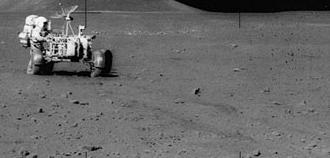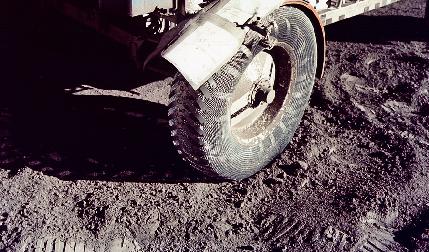drag and drop rover







|
 NASA: AS17-138-21039 |
The EVA video and transcript from this point in the mission show the astronauts working at the rear and sides of the rover, preparing for the scheduled activities at this station. They dusted the television camera lens, assembled sampling equipment, cleaned some equipment, covered the batteries, and took some gravimetric readings. In the photo above you can clearly see their footprints all over where the rover tracks should be.
Keeping in mind that dust flies great distances when the astronauts shuffle about, it is reasonable to believe that the tracks have simply been obliterated by the astronauts' feet during the hour of activity at Station 2.
In the full version of the long-distance photo available from the Apollo Lunar Surface Journal the rover tracks can be seen faintly on the right side of the image. Part of the problem with the conspiracist reasoning is the expectation that rover tracks ought always to be prominently visible. Even when there is no plausible reason for them being erased by subsequent activity, the tracks are simply not as visible to start with as people expect.
Here, for example, the astronauts are high up the slope of a mountain. It is reasonable to expect the dust to be thinner there than in the valley floor near the landing site, or on the plains where Apollo 11 landed. Thinner dust means the tires don't penetrate as far, leaving shallower tracks that aren't visible from a distance.
Below are some examples of shallow (but still visible) rover tracks.
 NASA: AS15-82-11091 |
 NASA: AS15-82-11201 |
The conspiracists argue that the rover may have been lifted into place as a prop. They may be half right. In lunar gravity the rover is not especially heavy. An astronaut can lift one end of it with little difficulty. And since the rover's turn radius, like that of any four-wheeled vehicle, is limited, the astronauts sometimes found it easier to lift one end of the rover and turn it so it pointed in the direction they wanted to go, rather than maneuvering through a three-point turn. When this occurred, there would obviously be no track leading up to the wheels.

 This and other photos
show the lunar rover with no tracks leading up to the tires. This
proves the rover was simply dropped or lifted into place as a
prop.
This and other photos
show the lunar rover with no tracks leading up to the tires. This
proves the rover was simply dropped or lifted into place as a
prop.
